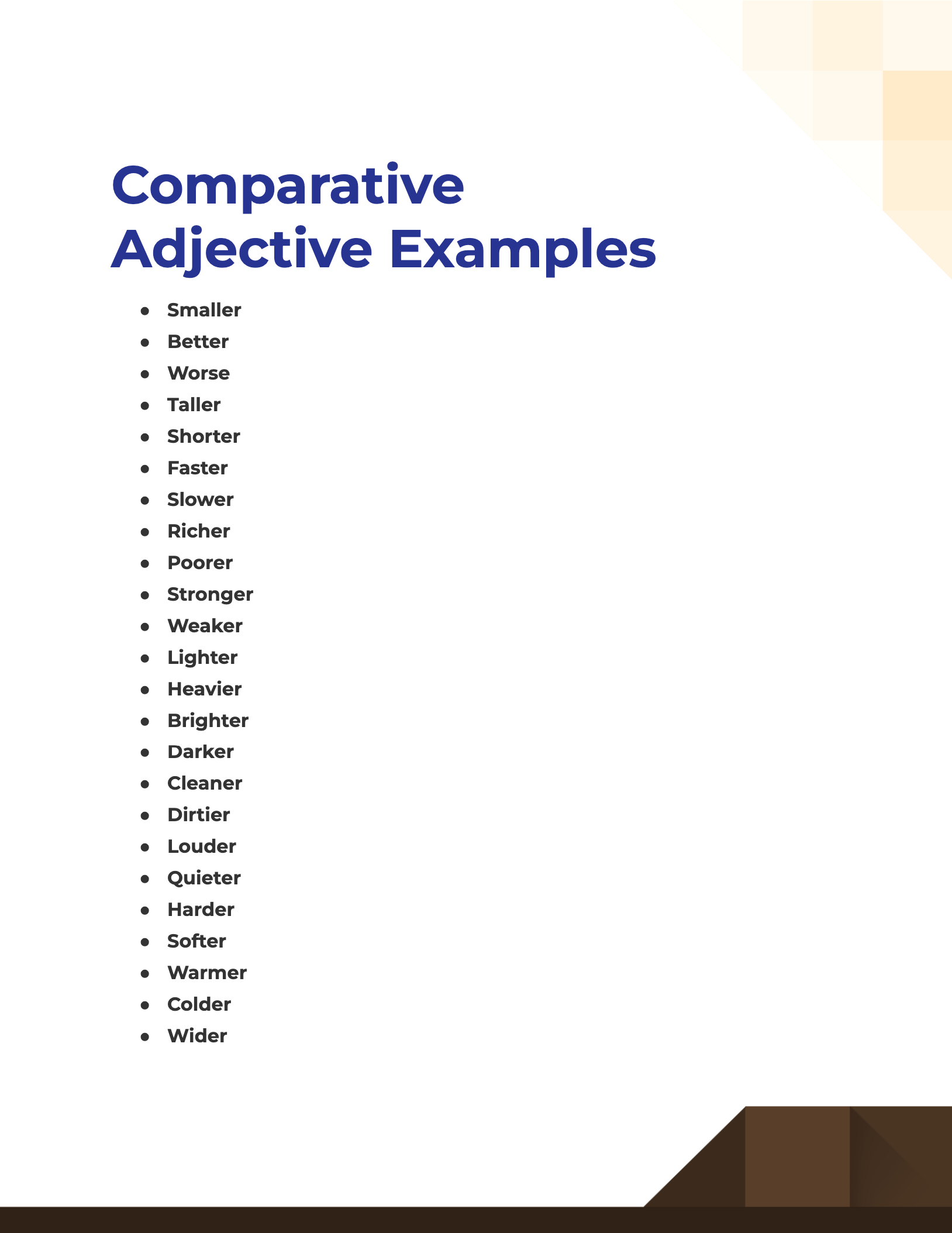99+ Comparative Adjective Examples
Master the art of comparison with comparative adjectives. These crucial language elements enable you to make comparisons between two nouns, enhancing the clarity and richness of your expressions. This comprehensive guide delves into the definition, best usage, adjective examples and tips for employing comparative adjectives effectively in your daily communication.
What is the Comparative Adjective? – Definition
A comparative adjective is an adjective modified to signify a higher or lower degree of a particular quality between two nouns. For example, if you say, “This book is better than that one,” the word “better” is a comparative adjective.
What is the Best Example of a Comparative Adjective?
One of the most illustrative examples of a comparative adjective is using “taller” to compare heights between two people. “John is taller than Mary” succinctly highlights that John has greater height relative to Mary.
100 Comparative Adjective Examples

Add depth to your conversations and writings by choosing the right comparative adjectives. Below is a list of 100 unique and distinct examples.
- Smaller
- Better
- Worse
- Taller
- Shorter
- Faster
- Slower
- Richer
- Poorer
- Stronger
- Weaker
- Lighter
- Heavier
- Brighter
- Darker
- Cleaner
- Dirtier
- Louder
- Quieter
- Harder
- Softer
- Warmer
- Colder
- Wider
- Narrower
- Higher
- Lower
- Deeper
- Shallower
- Thicker
- Thinner
- Fuller
- Emptier
- Closer
- Farther
- Newer
- Older
- Easier
- Tougher
- Safer
- Riskier
- Sharper
- Blunter
- Longer
- Briefer
- Happier
- Sadder
- Cheaper
- Costlier
- Fresher
- Staler
- Kinder
- Meaner
- Younger
- Elder
- Smarter
- Dumber
- Bigger
- Simpler
- Trickier
- Wetter
- Drier
- Finer
- Coarser
- Sweeter
- Sourer
- Neater
- Messier
- Healthier
- Sicker
- Calmer
- Angrier
- Wittier
- Duller
- Fancier
- Plain
- Braver
- Cowardly
- Nicer
- Naughtier
- Lazier
- Busier
- Saner
- Crazier
- Friendlier
- Hostile
- Fairer
- Biased
- Politer
- Ruder
- Spicier
- Blander
- Hotter
- Cooler
- Cleanlier
- Filthier
- Humbler
- Prouder
- Gentler
- Rougher
Comparative Adjective Sentence Examples
- This movie is more interesting than the last one we watched.
- The mountain trail is steeper than it looks in photos.
- She’s more focused than her brother.
- The second act was less engaging than the first.
- Her jokes are funnier than mine.
- His methods are less reliable than traditional techniques.
- The food here is tastier than at the other restaurant.
- The novel is more captivating than the summary suggested.
- This brand is cheaper but less durable than its competitor.
- The exam was easier than I had anticipated.
What are the Rules of Comparative Adjectives?
Understanding the rules governing comparative adjectives will enable you to employ them more effectively in your speech and writing. Here are some basic guidelines:
- Single-Syllable Adjectives: Add “-er” to the end of the adjective.
- Example: Fast becomes faster.
- Two-Syllable Adjectives Ending in “y”: Replace “y” with “ier”.
- Example: Happy becomes happier.
- Adjectives with Two or More Syllables: Use “more” or “less” before the adjective.
- Example: Beautiful becomes more beautiful.
- Irregular Adjectives: These don’t follow a consistent rule and need to be memorized.
- Example: Good becomes better.
- Double Comparatives: Avoid using “more” or “less” with adjectives that already end in “-er”.
- Incorrect: More faster
- Correct: Faster
What are the 3 Comparisons of Adjectives?
- Positive Form: The basic form of the adjective, used when you’re not making any comparisons.
- Example: Tall
- Comparative Form: Used to compare two nouns.
- Example: Taller
- Superlative Form: Used to compare more than two nouns, usually involves adding “-est” or using “most” or “least”.
- Example: Tallest
What are the Exercises to Practice Comparative Adjectives?
Improving your command of comparative adjectives involves regular practice. Here are some exercises to help you hone your skills:
- Fill in the Blanks: Complete sentences by choosing the correct form of the adjective.
- Example: This movie is ______ (interesting) than the last one.
- Sentence Formation: Use the given adjectives to form comparative sentences between two nouns.
- Example: [Car, Bike] + Fast
- Matching: Match the comparative adjective with its correct positive form.
- Example: Better – Good
- Multiple-Choice Questions: Choose the most appropriate comparative form for the given sentences.
- Example: She is ____(happy/happier) than her sister.
- Error Identification: Spot and correct the incorrect use of comparative adjectives in a given text.
- Story Comparison: Read a short story and re-write it using comparative adjectives to enhance the narration.
- Visual Comparison: Look at pictures of different objects, animals, or people and describe them using comparative adjectives.
- Dialogue Writing: Create a dialogue between two characters that makes extensive use of comparative adjectives.
- Flashcards: Use flashcards to memorize the comparative forms of irregular adjectives.
- Peer Review: Exchange exercises with a friend or classmate and correct each other’s work.
By consistently practicing these exercises, you’ll gain a strong grasp of comparative adjectives and how to utilize them to make your communication more effective and engaging.
How to Use a Comparative Adjective? – Step by Step Guide
- Identify the Nouns: Spot the two nouns you want to compare.
- Choose the Right Adjective: Select an adjective that appropriately describes a quality both nouns possess.
- Convert to Comparative Form: Alter the adjective into its comparative form by either adding “-er” or using “more” or “less”.
- Construct the Sentence: Frame your sentence to place both nouns and the comparative adjective in a logical arrangement.
Tips for Using Comparative Adjectives
- Avoid Double Comparatives: Don’t say “more better”; just say “better”.
- Be Consistent: Stick to either the “-er” form or the “more/less” form within a single context.
- Check Spelling: Some adjectives have irregular comparative forms, like “good” turning into “better”.
- Context Matters: Make sure the comparison makes sense in the context of what you’re discussing.
- Proofread: Always proofread to ensure the comparative adjectives are used appropriately.
Improve your writing and speech by understanding and applying these comparative adjective tips and examples. With a little practice, making comparisons will become second nature.



